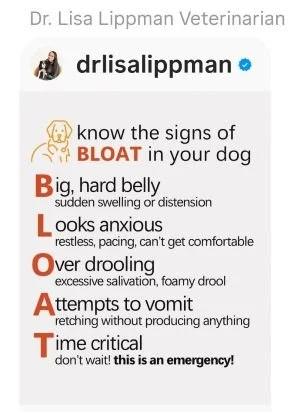Bloat in Dogs: Causes, Symptoms and Prevention
One of the sneakiest and life-threatening conditions that can strike dogs is what is commonly called bloat. Veterinarians refer to it as gastric dilatation-volvulus (GDV). In my pet first aid/CPR classes, I provide students with information that they need to quickly recognize bloat and an action plan to safely get that dog to the nearest veterinary clinic.
What Is Bloat in Dogs?
Bloat in dogs strikes when a dog’s stomach fills with gas, food, or fluid and then twists. This twisting traps gas and prevents the dog from releasing it. It causes a dangerous domino effect as this pressure buildup can cut off blood flow to vital organs. And, without veterinary care, a dog can die from bloat within a matter of hours.
One of my favorite veterinarians on this planet is Dr. Lisa Lippman. We met years ago in San Diego when she took my Pet First Aid 4U class. Today, Dr. Lisa is in New York City and is one of the top influential social media veterinarians in the world.
Dog Bloat Symptoms to Watch For
She understands that bloat can be sometimes hard to recognize, so she recently crafted this B.L.O.A.T. acronym that she posted on her Instagram account (drlisalippman). I share it here:
Know the Signs of BLOAT in Your Dog
Knowing them can help save their life.
Dog Breeds Most at Risk
Any dog can incur bloat, but large dogs and deep-chested breeds are at greater risk. Here is a rundown of breeds prone to bloat:
Boxers
Doberman Pinschers
German Shepherds
Great Danes
Irish Setters
Standard Poodles
Weimaraner
Why these breeds? Their deep chests allow the stomach to twist more easily inside the abdomen.
Causes and Risk Factors
The exact cause of canine bloat isn’t always clear, but several factors increase the risk:
Consuming one large meal per day instead of two or three smaller portioned meals
Eating too quickly or gulping air
Exercising right after eating, including games of fetch, agility and vigorous walks
Stress or anxiety
Advanced age. Older dogs are more prone for bloat.
Treatment for Bloat in Dogs
If your dog is showing signs of bloat, get emergency veterinary help immediately. Treatment typically involves:
Stabilizing the dog with IV fluids and oxygen
Decompressing the stomach to release trapped gas
Surgery to untwist the stomach and prevent recurrence (a procedure called gastropexy)
Early treatment dramatically improves survival rates.
How to Prevent Bloat in Dogs
While not all cases can be prevented, you can reduce your dog’s risk of developing bloat:
Feed two to three smaller meals per day instead of one large one
Use a slow-feeder bowl to prevent gulping down food too quickly.
Avoid vigorous activity right before or after meals for at least 30 minutes, preferably 45 minutes to an hour.
Keep your dog’s environment calm during feeding time by allowing dogs to eat in crates or separated from other pets.
Ask your vet about preventive gastropexy surgery, especially for high-risk breeds like Great Danes.
When to Call Your Vet
If you ever notice a bloated stomach in your dog, don’t wait and see if it improves. Call ahead and take that dog to an emergency veterinary clinic immediately. Do not wait. Calling ahead gives the vet team advance notice to be able to immediately treat the dog upon your arrival.
Key Takeaways
Bloat in dogs is a critical condition that every dog owner should recognize. By knowing the symptoms, causes, and prevention tips, you can act fast and help keep your dog safe.
Early recognition and immediate veterinary care can make the difference between life and death.
Final tip: Show your dog and cat how much you care for them by enrolling in one of our Pet First Aid 4U classes. We offer three options for you to earn veterinarian-approved two-year certificates:
In-person classes primarily aimed at pet professionals and first responders
Interactive via ZOOM classes offered monthly and on demand
Self-paced online classes for those wishing to learn anytime, anywhere.
Pick the best option for you and sign up today!
About the Author:
Arden Moore, founder of Pet First Aid 4 U, is a Master Pet First Aid/CPR Instructor who teaches veterinarian-approved, hands-on safety courses alongside her teaching team of Kona (dog) and Casey (cat). Known as “The Pet First Aid & Safety Coach,” Arden is also a nationally recognized behavior consultant, bestselling author of over 25 pet books, and the award-winning host of the “Oh Behave!” podcast. A Fear Free Certified Professional, she brings decades of pet expertise to all her endeavors — with a mission to help pets live safer, longer and healthier lives.

